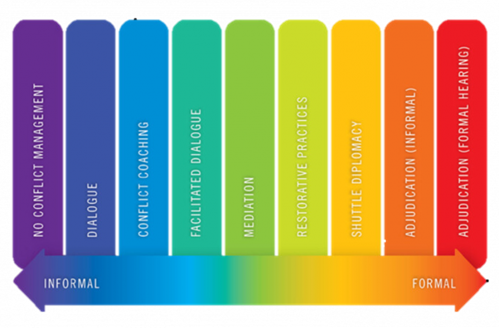A Spectrum of Conflict Approaches

As we listen to and work with our visitors, one common refrain is that many people understand that Emory offers a wide range of policies and resources for managing conflict, but they are confused and/or overwhelmed by the differences in what they do. Part of our work as Ombuds is to help these visitors understand how the Emory’s various offices and programs differ from one another in what they offer with respect to managing conflict.
This insight has led us to begin developing a “conflict map” that will help guide community members to the resources that can best assist them. As part of that project, we realized that we also need a simple, clear way to make sense of what kinds of conflict management options each resource at Emory offers. Fortunately, there was already a very helpful model: the “Spectrum Model of Conflict” developed by Schrage & Thompson (2009).
Schrage & Thompson's Spectrum Model starts from the observation that approaches to conflict within an organization can be organized along a spectrum from informal, low involvement on the part of the organization itself to more formal, high involvement by the organization. On the informal side of the spectrum, conflict approaches are party driven, though the parties may be supported by resources on campus. For instance, a student may decide they do not wish to address a conflict directly but would instead like to speak to someone about the harm and obtain tools to help them cope. In the middle of the spectrum, parties received neutral guidance from a trusted advisor, but are still in control of the process and outcome. On the formal side of the spectrum, parties cede control over the process and outcome to a third party who will decide.
Specific elements of this Spectrum Model include:
No Conflict Management. Parties intentionally refrain from addressing a conflict. (Example: a faculty member decides to let a perceived slight slide.)
Dialogue. Parties engage in self-initiated conversation to better understand one another or manage a conflict without third-party involvement. (Example: roommates decide to talk about schedules.)
Conflict Coaching. Parties obtain advice from a neutral third party on how to address their conflict (either self-initiated or suggested by others). (Example: Ombuds or FSAP assists a visitor in planning a difficult conversation with a manager.)
Facilitated Dialogue. Parties engage in conversation with one another guided by the aid of a neutral third party who helps overcome communication barriers and identify mutual interests. (Example: Ombuds works with students who have had a disagreement over a miscommunication.)
Mediation. Parties engage in a more structured conversation, either at their own initiation or at the request of administrators, with the goal of creating a plan for the future. (Example: FSAP or the Ombuds conducts a mediation between two employees to find a way to work together more effectively.)
Restorative Practices. The community provides space for individuals to take ownership of harmful behavior and work with the parties affected by that behavior to address the harm.
Shuttle Diplomacy. A trusted third party actively negotiates a resolution between two parties who do not wish to engage directly with one another. (Example: Ombuds serving as intermediary).
Informal Adjudication. Administration officials or leaders meet with a person to address harmful behavior that violates a set policy. The party waives a formal process and accepts responsibility, agreeing to fulfill ordered sanctions. (Example: Honor Council Informal Resolution.)
Formal Adjudication. Following a set policy and procedure, administration officials conduct a formal process that includes a hearing, in which a third party (panel or judge) decides whether an alleged violation of policy occurred and any sanctions that apply. (Example: Student Conduct Code formal hearing).
A healthy, integrated conflict management system offers resources and options along the full spectrum of approaches here—and that is true at Emory. Each resource at Emory offers some part of this spectrum; together, these resources offer the full “rainbow” of ways to address conflict. By identifying which resources focus on which conflict approaches, we believe we can help our community make sense of how all these resources fit together into an integrated whole and choose the resources that can best assist them.
This model will form the basis of our conflict map project. Of course, the office of the Ombuds is a vital part of this spectrum offering informal support on both the left and middle parts of the spectrum. The Ombuds also offers guidance about each of these approaches from a neutral, independent standpoint, the better to assist you in deciding what approach best fits your situation and goals.